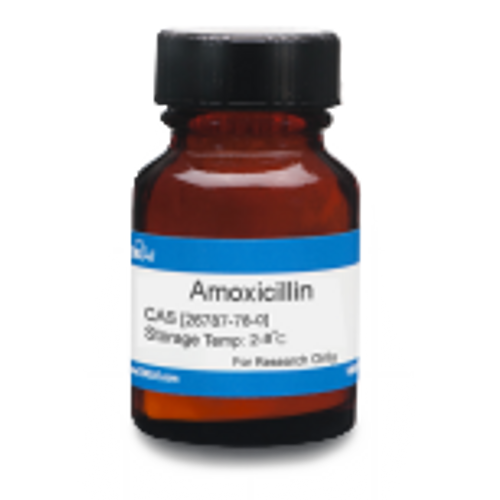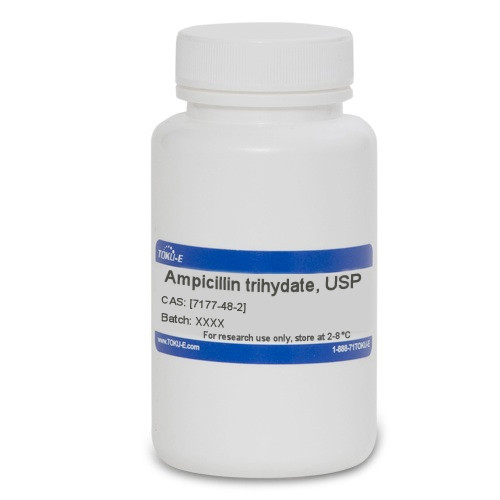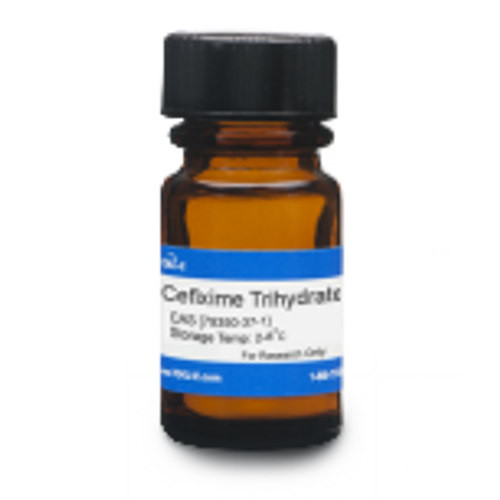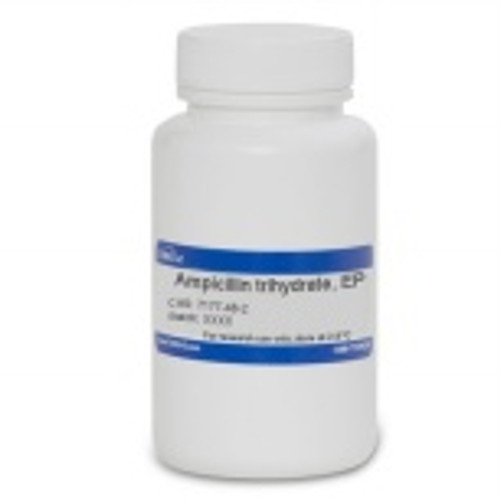Amoxicillin Trihydrate, USP is an extended spectrum β-lactam antibiotic similar in structure to Ampicillin. Resistance to Amoxicillin can be attributed to β-lactamase enzymes secreted by resistant cells. The compound is effective against a variety of Gram-negative and Gram-positive bacteria.
Amoxicillin Trihydrate is slightly soluble in water.
Ampicillin Trihydrate, USP conforms to United States Pharmacopoeia specifications.
We also offer:
| Mechanism of Action | Like all β-lactams, Amoxicillin targets PBP’s (penicillin binding proteins) involved in the final phase of peptidoglycan synthesis. PBP’s are enzymes which catalyze a pentaglycine crosslink between alanine and lysine residues. Without a pentaglycine crosslink, the integrity of the cell wall is severely compromised ultimately leading to the death of the cell. |
| Spectrum | Amoxicillin targets a wide range of β-lactamase negative Gram positive and Gram negative bacteria including E. coli and a number of Streptococcus and Staphylococcus species. Interestingly, Amoxicillin has been found to be effective against certain β-lactam sensitive VRE or vancomycin resistant Enterococcus; a glycopeptide antibiotic resistant "superbug." |
| Microbiology Applications | Amoxicillin is commonly used in clinical in vitro microbiological antimicrobial susceptibility tests (panels, discs, and MIC strips) against Gram-positive and Gram-negative microbial isolates. Medical microbiologists use AST results to recommend antibiotic treatment options. Representative MIC values include:
|
| Eukaryotic Cell Culture Applications | Dendritic cells were incubated with supernatant from Amoxicillin-treated hepatocytes to characterize drug-specific signaling pathways between hepatocytes and immune cells to study the influence of the compound on the immune response (Ogese, 2017). |
| Molecular Formula | C16H19N3O5S •3H2O |
| Solubility | Benzene: Insoluble Carbon tetrachloride: Insoluble Chloroform: Insoluble Methanol: Slightly soluble Water: Slightly soluble |
| References |
Ogese MO (2017) Characterization of drug-specific signaling between primary human hepatocytes and immune Cells. Toxicol Sci. 158(1):76-89 PMID 28444390 Pitout JD, Sanders CC, Sanders WE (1997) Antimicrobial resistance with focus on beta-lactam resistance in Gram-negative bacilli. Am J Med 103(1):51-59. PMID 9236486 Worlitzch D et al (2001) Effects of Amoxicillin, gentamicin, and moxifloxacin on the hemolytic activity of Staphylococcus aureus in vitro and in vivo. Antimicrob Agents Chemother. 45(1):196-202 PMID 11120965 Yazdanbakhsh AR et al (2016) Performance of iron nano particles and bimetallic Ni/Fe nanoparticles in removal of amoxicillin trihydrate from synthetic wastewater. Water Sci and Technol. 73(12):2998-3007 |
| MIC | Aggregatibacter actinomycetemcomitans| 1 - 16| Bacillus cereus| 4 - 31.25| Bacillus pumilu| 1| Bacillus subtilis| 0.05 - 412| Bacteroides distasonis| 2 - >128| Bacteroides fragilis| ≤0.25 - ≥512| Bacteroides ovatus| 16 - >128| Bacteroides thetaiotaomicron| 16 - >128| Bacteroides uniformis| 16 - >128| Bacteroides vulgatus| 8 - >128| Bifidobacterium spp.| ≤0.125 - 0.5| Borrelia burgdorferi S.L.| 0.03 - 2| Burkholderia cepacia (8Q)| >18| Burkholderia mallei (Pakistan)| 128| Campylobacter gracilis (ATCC 33236)| 1| Campylobacter helveticus (ATCC 51209)| 4| Campylobacter jejuni| 0.5 - 2| Campylobacter rectus (ATCC 33238)| 1| Campylobacter showae (ATCC 51146)| 0.5| Capnocytophaga gingivalis (ATCC 33624)| 0.5| Capnocytophaga ochracea (ATCC 27872)| 1| Capnocytophaga spp.| 1| Capnocytophaga sputigena (ATCC 33612)| 1| Citrobacter diversus| >1000| Citrobacter freundii| 2 - 2048| Clostridium bifermentans| ≤0.125 - 0.5| Clostridium cadaveris| ≤0.125 - 0.5| Clostridium difficile| 1 - 4| Clostridium histolyticum | ≤0.125 - 0.5| Clostridium perfringens| ≤0.03 - 0.5| Clostridium ramosum| ≤0.125 - 0.5| Clostridium sordellii| ≤0.125 - 0.5| Clostridium spiroforme| 0.032 - 0.5| Clostridium spp.| ≤0.125 - 0.5| Clostridium tertium| ≤0.125 - 0.5| Corynebacterium matruchotii (ATCC 14266)| 0.5| Corynebacterium spp. (HEGP 1006)| >256| Edwardsiella hoshinae | 0.13 - 0.25| Edwardsiella ictaluri | 0.13 - 1| Edwardsiella tarda| 0.13 - 64| Eikenella corrodens| 2 - 8| Enterobacter cloacae| 4 - >500| Enterobacteriaceae| 0.25 - 128| Enterococci| 0.12 - 128| Enterococcus faecalis| 0.25 - 7| Enterococcus faecium| 32 - >256| Escherichia coli| 2 - >500| Eubacterium saburreum (ATCC 33271)| 0.5| Eubacterium spp.| 1| Eubacterium sulci (ATCC 35585)| 0.5| Fusobacterium mortiferum| 1 - >128| Fusobacterium necrophorum| ≤0.125 - 0.5| Fusobacterium nucleatum| ≤0.125 - 16| Fusobacterium periodonticum (ATCC 33693)| 32| Fusobacterium spp.| ≤0.125 - >128| Fusobacterium varium| 1 - 2| Gemella morbillorum (ATCC 27824)| 0.5 - ?| Haemolytic streptococci| 0.008 - 0.12| Haemophilus ducreyi| 9| Haemophilus influenzae| <0.07 - >64| Haemophilus parasuis| 0.6 - 310| Haemophilus spp.| 0.06 - 128| Helicobacter bilis (ATCC 51630)| 4| Helicobacter mustelae (ATCC 43772)| 4| Helicobacter pullorum (ATCC 51864)| 4| Helicobacter pylori| 0.0002 -8| Klebsiella pneumonia| 2 - >500| Lactobacillus acidophilus| ≤0.125 - 2| Lactobacillus buchneri | 0.25 - 1| Lactobacillus plantarum| ≤0.125 - 2| Lactobacillus reuteri| ≤0.125 - 4| Lactobacillus rhamnosus| 0.5 - 2| Lactobacillus salivarius | ≤0.125 - 0.5| Lactobacillus spp.| 0.5 - 129| Lactococcus lactis| ≤0.125 - 1| Leptotrichia buccalis (ATCC 14201)| 0.5| Leuconostoc | ≤0.125 - 1| Micrococcus| <0.24 - >40| Moraxella catarrhalis (BC1)| <0.07| Morganella morganii| >100 - 512| Mycoplasma hyopneumoniae| 0.09 - 737.3| Mycoplasma hyorhinis| 0.09 - 737.3| Neisseria gonorrhoeae| 0.3| Neisseria meningitidis (N2)| <0.07| Neisseria mucosa (ATCC 19696)| 2| Neisseria spp.| 0.004 - 32| Nocardia asteroides| 6.2 - ≥400| Ochrobactrum anthropi (SLO74)| ≥28| Pasteurella multocida| 128 - 1240| Pediococcus | ≤0.125 - 1| Peptostreptococcus anaerobius| ≤0.125 - 32| Peptostreptococcus asaccharolyticus| ≤0.125 - 32| Peptostreptococcus magnus| ≤0.125 - 32| Peptostreptococcus micros| ≤0.125 - 32| Peptostreptococcus prevotii| ≤0.125 - 32| Peptostreptococcus spp.| <1 - 8| Peptostreptococcus tetradius| ≤0.125 - 32| Pneumococci| 0.008 - 4| Porphyromonas asaccharolytica| ≤0.0125 - 64| Porphyromonas endodontalis (ATCC 35406)| 4| Porphyromonas gingivalis| ≤0.0125 - 64| Porphyromonas spp.| ≤0.125 - 128| Prevotella bivia| ≤0.125 - 128| Prevotella buccae| ≤0.0125 - 64| Prevotella corporis | ≤0.0125 - 64| Prevotella disiens| ≤0.0125 - 64| Prevotella intermedia| ≤0.0125 - 64| Prevotella loescheii| ≤0.0125 - 64| Prevotella melaninogenica| ≤0.125 - 128| Prevotella nigrescens| 0.5| Prevotella oralis (group)| ≤0.0125 - 64| Prevotella oris| ≤0.0125 - 64| Prevotella spp.| ≤0.125 - 128| Propionibacterium acnes| ≤0.125 - 0.25| Proteus mirabilis (1287)| 0.39| Proteus vulgaris| 1 - 1024| Providencia rettgeri (NIH 96)| 3.13| Pseudomonas aeruginosa| 1 - 1024| Ralstonia pickettii| 64| Salmonella spp.| 1| Salmonella typhi| 6.25 - 32| Selenomonas noxia| 0.5| Serratia marcescens| 16 - >256 - ?| Shigella flexneri| 2| Staphylococci| 0.03 - 128| Staphylococcus aureus| <0.0625 - >128| Staphylococcus aureus (methicillin-resistant)| 0.2 - 512| Staphylococcus epidermidis| 0.78 - 1| Staphylococcus faecalis| 1.22 - 1.95| Streptococcus agalactiae | 0.094| Streptococcus anginosus| 0.5| Streptococcus bovis| ≤0.125 - 1| Streptococcus constellatus (ATCC 27823)| 0.5| Streptococcus equi | 0.03 - 0.06| Streptococcus faecalis (ATCC 29212)| 412| Streptococcus gordonii (ATCC 10558)| 0.5| Streptococcus infantarius | ≤0.125 - 1| Streptococcus intermedius (ATCC 27335)| 1| Streptococcus mitis (ATCC 49456)| 0.5| Streptococcus oralis (ATCC 35037)| 0.5| Streptococcus pneumonia| ≤0.008 - 31.25| Streptococcus pyogenes| 32| Streptococcus sanguinis| 1| Streptococcus spp.| 32 - 128| Streptococcus suis| 78 - 1240| Tannerella forsythia| 8| Veillonella parvula| 0.5| Weissella spp.| ≤0.125 - 0.25| Xanthomonas oryzae| 18| |








